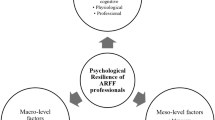Abstract
The aim of the ethnographic research reported here was to increase knowledge concerning the values and social and emotional characteristics of 9/11 responders in order to benefit others in subsequent manmade disasters. The research is based on a series of in-depth interviews conducted with ground zero first responders; firefighters, police officers, fire and police chaplains, and media persons. The materials that emerged from the study indicate that psychodynamic concepts, such as post-traumatic stress, may be too individualistically formulated to take into account the significant factors that acted as the basis for the resilience of these responders.
Similar content being viewed by others
REFERENCES
American Psychiatric Association (1994). Diagnostic and statistical manual of mental disorders (4th ed. ). Washington, DC: American Psychiatric Press.
Bloom, S. L. & Reichert, M. (1998). Bearing witness: Violence and collective responsibility. New York: The Haworth Maltreatment and Trauma Press.
Fox, R. C. (1988). The human condition of health professionals. InR. C. Fox (Ed. ), Essays in medical sociology: Journeys into the field (pp. 572–587, especially p. 586). Second enlarged edition. New Brunswick (USA) and Oxford (UK): Transaction Books.
Grinker, R. R., & Spiegel, J. (1963). Men under stress. New York: McGraw Hill.
Hedges, C. (2002). War is a force that gives us meaning. New York: Anchor Books.
Henry, V. E. (2004). Death work: Police, Trauma, and the psychology of survival. New York: Oxford University Press.
Herman, J. L. (1992). Trauma and recovery. New York: Basic Books.
McCauley, C. (2003). Men in Combat. www. psych. upenn. edu/sacsec/online/bib-agg. htm.
North, C. S., Tivis, L. McMillen, J. C., Pferfferbaum, B., Cox, J., Spitznagel, E. L., Bunch, K., Schorr, J., & Smith, E. M. (2002). Coping, functioning, and adjustment of rescue workers after the Oklahoma City bombing (pp. 171–175). Journal of Traumatic Stress, 15.
Perlman, H. H. (1957). Social casework: A problem-solving process. Chicago: University of Chicago Press.
Smalley, R. E. (1967). Theory for social work practice. New York: Columbia University Press.
Smith, D. (1972, 1999). Report from engine Co. 82. New York: Warner Books.
Smith, D. (2002). Report from ground zero. New York: Viking.
Stouffer, S. A. (1965, c1949). The American soldier. New York: John Wiley & Sons.
The Staff of The New York Times (2002). Portraits: 9/11/01: The collected portraits of grief from the New York Times. New York: The New York Times.
Von Essen, T. (2002). Strong of heart: Life and death in the fire department of New York. New York: Regan Books.
Williams, R. (2002). Writing in the dust: After September 11. Grand Rapids, Michigan/Cambridge, UK: William B. Eerdmans Pub. Co.
Author information
Authors and Affiliations
Rights and permissions
About this article
Cite this article
Freedman, T.G. Voices of 9/11 First Responders: Patterns of Collective Resilience. Clinical Social Work Journal 32, 377–393 (2004). https://doi.org/10.1007/s10615-004-0538-z
Issue Date:
DOI: https://doi.org/10.1007/s10615-004-0538-z




